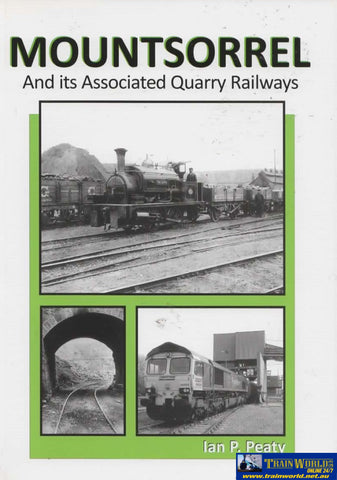Mountsorrel: And its Associated Quarry Railways (IR382)
Product No.: IR382
Title: Mountsorrel: And its Associated Quarry Railways
Author(s): Peaty, Ian P.
Illustrator(s): N/A
Publisher: Irwell Press
ISBN: 9781906919382
Condition: New
Binding: Softcover
Dust Jacket: None
Edition: 1st Edition
Publication Year: 2012
Features: 88 Pages with Black/White Photos.
The geology of Leicestershire is dominated by the igneous rocks which form the beautiful Charnwood Forest, immediately to the west of Leicester city. The eastern boundary is formed by the river Soar and its navigation on a north-south line. Running in this river valley is the former Midland Railway four track main line to Derby and Nottingham. To the east are the Lower Lias beds which reach a depth of over nine hundred feet and have been actively worked for over a hundred years.
This activity is now conducted underground and the modern works, producing plaster products, are at Barrow-on-Soar, opposite the railway sidings of the Lafarge granite stone loading terminal. To the west, at Coalville, coal has been extracted in and around the appropriately named town. The renowned Snibston Mine is now a museum under the management of the Leicestershire Museum Service. Other collieries were at Whitwick, where there was also a granite quarry, and a few miles south there were Ellistown, Ibstock, Desford, Nailstone and Measham Collieries; further west was the well known Moira Colliery near Burton-on-Trent.
The east-west extent of the granite area is eight miles and north-south it extends for some sixteen miles. At the northern extremity was the Shepshed quarry while the southern-most quarrying took place at Stoney Stanton and Narborough, bounded by the old South Leicester line of the LNWR. All the coal collieries and the granite quarries of any size were once served by railways; many of the quarries had their own railway networks, complete with a wonderful range of locomotives and private owner wagons, employing several different gauges.
Today the largest granite quarry in Europe, Mountsorrel, lies on the north-eastern boundary; it still has a considerable private railway system in the ownership of the giant French aggregates business Lafarge Aggregates. On the western and southern areas, another firm, Aggregates Industries, have smaller railways, at Bardon Hill and Croft Quarries. Close to the coal measures is Stud Farm rail ballast loading plant; formerly owned by Tarmac Ltd, a narrow gauge railway connected it to the quarry at Markfield.



